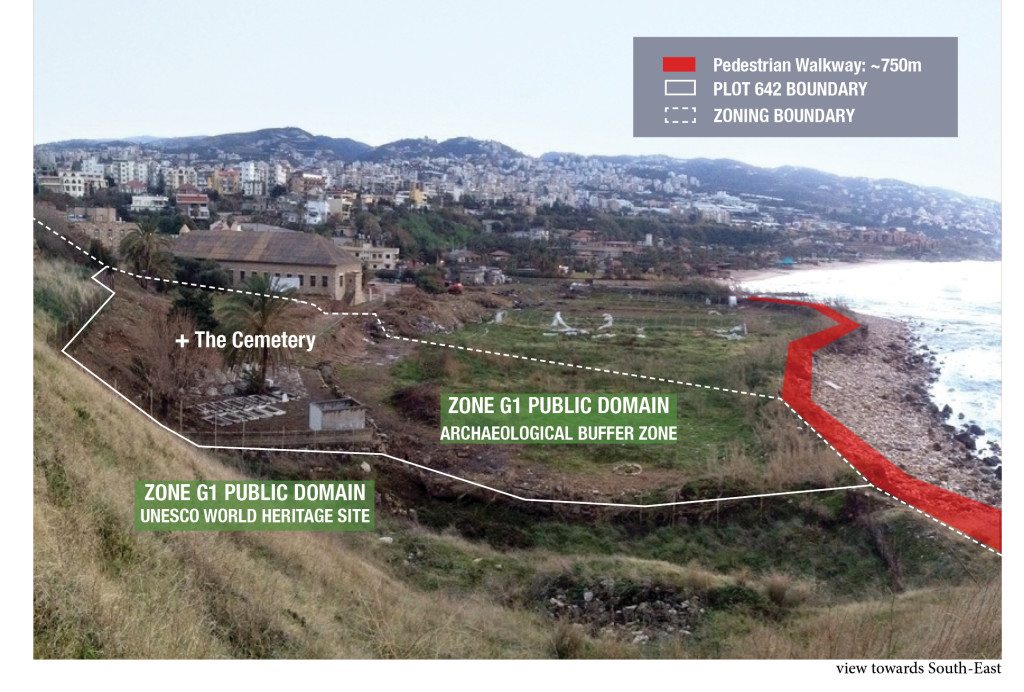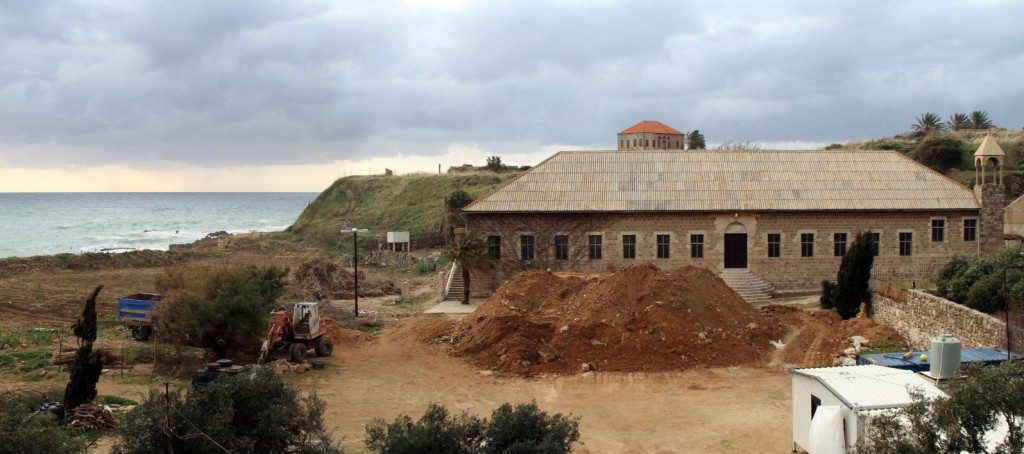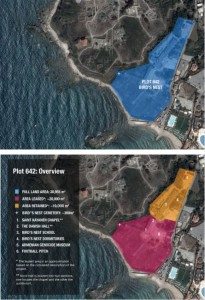BEIRUT, Lebanon (A.W.)—Over the past few months, reports have appeared in various media outlets claiming that a a luxury beach resort will be built on two-thirds of the historic Bird’s Nest Orphanage plot in Jbeil, Lebanon (see map for exact areas). In early February, the Board of Directors of Bird’s Nest (Trchnots Pooyn, in Armenian) informed the community—particularly the relatives of those who are buried in the cemetery—that plans for the site now envision relocating the 33 individual graves to 2 collective tombs on the upper part of the plot. Around two-thirds of the graves are of orphans; one-third are of genocide survivors or employees of the orphanage born before 1915. The decision to relocate the bodies was purportedly made to “bring the remains of these orphans closer to the grave of Maria Jacobsen, the founder of the orphanage.” They will rest next to a new museum dedicated to the orphans and to the orphanage. The museum is slated to officially open on July 18.

The Bird’s Nest Cemetery after workers attempted to relocate one of the graves on the right (Photo: Vartan Avakian)
The church released a statement in late February that reads, “Taking into account the financial difficulties that the Bird’s Nest has been facing, and the abandoned state of the seaside area of the plot, it was found appropriate to lease the mentioned land to be used by families for social and sporting purposes. The tenant is former Minister and Mayor [of Jbeil] Jean Louis Kordahi. A memorandum of understanding has been signed between the tenant and the Catholicosate of the Greater House of Cilicia detailing the duration, and purpose of use of the land.”
Vartan Avakian, the great-grandson of Hagop Avakian, who was born in 1894 in Fendijak, Cilicia (Ottoman Empire), and who was among the earliest genocide survivors to settle in Lebanon and to later be buried in this cemetery, researched the church’s plan and began lobbying against the project. When all attempts failed, opponents of the project created a website and an online petition to raise awareness among the public, and to explain the reasons behind their objection.
Last week in an interview with Cilicia TV, Seta Khedeshian, the executive director of Bird’s Nest, labeled the outspoken critics of the project as “irresponsible,” and accused them of spreading “false information.” She said the plan to move the graves was made prior to the new plans, and that by relocating the graves it was the committee’s goal to offer visitors a testimony of the lives of the orphans of the genocide and the that care “Mama” Jacobsen provided the children. Khedeshian, however, did not address some of the main concerns of the opponents of the plan that were raised in the petition, which has garnered more than 800 signatures.
Concerns over the Project
Bird’s Nest is historically symbolic for the Armenians of Byblos, Lebanon, and the to the diaspora in general. It is a testimony of the will of the Armenian people to survive, live, and create despite the genocide. For many members of the community in Byblos, it also represents the center around which the Armenian neighborhood was later formed.
Opponents of the plan argue that the beachfront project would not only harm the character of the site and disrupt the residents’ sense of belonging, but would also affect two important landmarks situated on the plot: the cemetery and Nicol Hall, which houses the St. Kayane Chapel.
Exhuming the Bodies of Genocide Survivors
The Bird’s Nest Cemetery is viewed by many as a memorial to Lebanon’s historical role as a refuge for victims of humanitarian catastrophes. Each of the 33 graves of the Armenian Genocide survivors is a testimony to and legacy of their journey and survival. Removing their bodies from what should have been their final resting place and into a “mass grave” is a tragic disruption, argue opponents of the plan. “The symbolism behind moving people who have survived the genocide … from their individual tombs to a collective mass grave, seems to have escaped the decision makers,” says Vartan Avakian. “A collective mass grave is a symbol of genocide rather than survival.”
In the interview with Cilicia TV, Khedeshian claimed that the cemetery has long been neglected, and that some of the graves no longer bear the names of the deceased, nor are they visited by their families. A nearby resident, however, related that families visit the cemetery at least twice a year on Merelots, that the site is seen as a place of pilgrimage, and that it is often visited during genocide commemoration events, even if it is poorly maintained by the institution in charge.
As the map shows, the surface area of the cemetery, which located on the east side, is 250 square meters (roughly 2,691 square feet, or 1 percent of the area of the plot), and is classified as public domain under the zoning regulation for the preservation of the historical site of Byblos.* Furthermore, the municipality of Byblos has plans to construct a pedestrian walkway bridging the old port of Byblos to Armenia Street. This new walkway would give the cemetery of the genocide survivors its due value by improving its visibility and accessibility. Importantly, the cemetery also lies in the buffer zone of a UNESCO World Heritage Site, a unique spot for a genocide memorial.
On June 29, without any legal documentation, workers began digging at the site. They were stopped by members of the Avakian family, who had obtained a court order to temporarily halt the construction activities in the cemetery.
The online petition urges the Catholicosate to put an end to the destruction of the cemetery for ethical and historical reasons, taking into consideration that it comprises only 1 percent of the 20,000 square meters (or about 215,278 square feet) of the land being leased.
“[Mass graves] occur when unidentified or ownerless human remains or bodies are found as a result of mass murders or massacres,” wrote architect Diran Harmandayan on the petition page. The graves at the Bird’s Nest “are not ownerless or unidentified. They belong in the first place to the Armenian community in Lebanon and to the Lebanese at large, as a heritage, and constitute authentic witnesses of the calvary of the Armenians who found refuge in Lebanon.”
Nicol Hall – St. Kayane Chapel
Since the zoning and building laws in Lebanon do not allow for any more permanent structures to be erected on this plot, the plan will appropriate the 1921 Nicol Hall, which was built by the orphans, and either demolish it or use it as the main building for the resort. It will also house a restaurant and a boutique hotel, according to the architectural plans reviewed by some of its critics.
Khedeshian claimed that Nicol Hall has long been a dining hall that only recently was being used as a church. However, some Byblos residents say that the hall has two sections: The Danish hall, which was used as an auditorium by the orphans and later by the residents, and the St. Kayane Chapel, which has served as the only place of worship for Armenians in Byblos since prior to the 1950’s. In fact, the structure is recognized as a church in the Real Estate Certificate and Cadastral Survey of 1949.
The questions that have been raised seem to be: How ethical is it for a religious institution to lease land of such historical and cultural value for a luxury beach resort? And should the fate of a building that dates back to the early 1900’s, that was used as a church and as a school facility by those saved from the genocide, be turned into a resort or a restaurant?
The petition calls for the preservation of the St. Kayane Chapel because the current plan, if carried out, will erase an important part of Armenian history, memory, and patrimony in Byblos.
Issues of Transparency
The interview with Khedeshian, although it aimed to clarify the so-called “fallacies” that have been circulating in the media, did not clarify important details about the project.
No clear report has yet been given regarding the type and scope of the project, although Khedeshian stated that the Bird’s Nest Committee had issued announcements detailing each and every plan the institution foresees for the site.
The committee did not circulate a map of the leased area or clarify the number of years it will be leased, the type of deal made between the institution and the investor, and how the institution stands to profit from the project.
When asked about what it will gain from this “profitable project,” Khedeshian simply said that a new church, worth $1 million, will be built on the upper part of the plot, and a few structures will be renovated.
Opponents to this development say that such a project should be openly discussed in a town hall-style meeting with the presence of community members, as well as professionals in the fields of architecture, heritage, urban planning, and archeology. And that it is the right of every Armenian and Lebanese at large to question the proposed project, especially as it includes plans that so significantly affect the cemetery.
Real profits vs. Real Losses
The fact that the institution would like to use its empty land to cover its expenses may seem reasonable to many, including some of the opponents of the beach resort project. Khedeshian argued that the cost of maintaining the property has increased, and that the financial flow from external sources has dried up. If the plan succeeds, she said, the developer would offer $1 million to construct a new church on site. She insisted that no structures would be demolished.
Yet, there needs to be a proper understanding of the history of the site, proper respect shown to its many components, an appreciation and preservation of the value each carries, and consideration of its meaning to the people, insist opponents of the plan.
One recurring question that they are asking is: What would the institution lose if the cemetery were to remain in place, at the edge of the plot, and an investment that respects the historical and national heritage of Bird’s Nest is designed for the rest of the land?
Although the Bird’s Nest Committee has repeatedly stated that the relocation of the graves is within the scope of another project—that of bringing them closer to the resting place of Maria Jacobsen—opponents fear that it is largely motivated by the desire to make way for the new seafront development, as a resort adjacent to a cemetery might not be too appealing for vacationers.
“The 33 graves are history’s witnesses in the face of humanity that will convey their powerful message only if kept in their natural state. They should not be subject to any change,” said architect and urbanist Arpi Mangassarian, adding that with a little landscaping, the site could become an important destination for visitors of Byblos and Lebanon.
* The Directorate General of Antiquities refused an early plan to develop the section of the plot adjacent to the archeological site and has identified it as an archeological buffer zone. The 4,000 square meters where the cemetery is situated is in the buffer zone of a World Heritage Site.
The post Stirring Up the Bird’s Nest? appeared first on Armenian Weekly.



